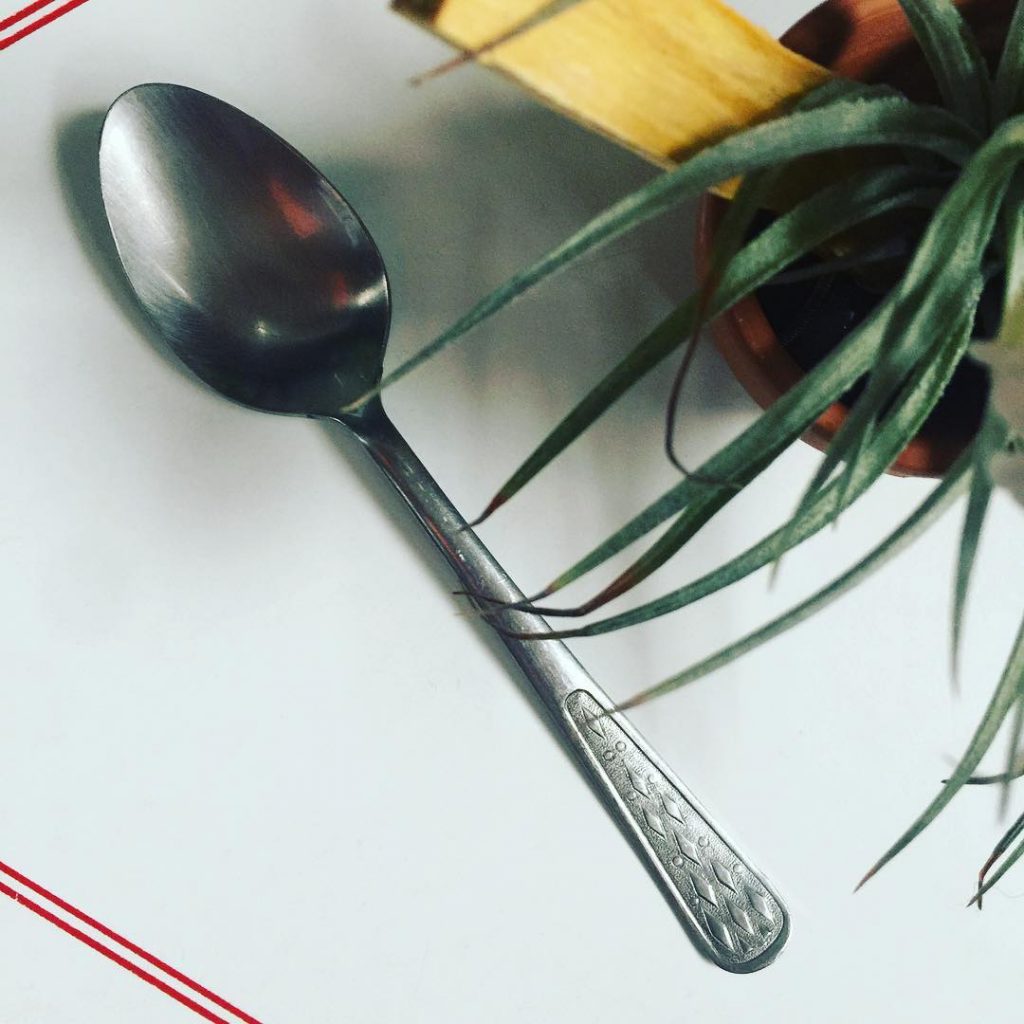I’ve mentioned before that one of my culinary goals is to learn to make the foods I crave instead of being dependent on dining out. For one thing, as we become more mobile, we won’t have access to our favorite restaurants. For another, we’re always looking for ways to cut costs, and dining out is expensive. I’m going to write a little more about this next week, but for now, let’s just say that I’ve cut our food costs by 40% just by preparing most of our meals in our humble galley.
One of the foods I find myself hankering after frequently is chicken tinga, which I had for the first time at Felipe’s in New Orleans. It’s spicy and sloppy and so good with salsa fresca. Unlike the kone ni makondo from Bennachin’s, which I wrote about earlier here, information on chicken tinga abounds, and there are plenty of recipes to crib from.
However, you know how I feel about recipes. A recipe is somebody telling me what to do, and I don’t like being told what to do. As a proud student of the School of Hard Knocks, I prefer general guidelines followed by experimentation. I enjoy using my intuition and some exploration to crack the codes of my favorite dishes.
Plus, recipes often make dishes seem more complicated than they really are, which sucks the fun right out of cooking. I can’t tell you how many years I avoided the kitchen just because my eyes would start to glaze over when I looked at arm’s length ingredient lists and intimidating cooking techniques. So let me say it plainly:
Cooking doesn’t have to be complicated.
When it comes right down to it, kone ni makondo is black-eyed peas in a tomato and onion stew. That’s it. Do with it what you will – use palm oil or vegetable oil, add ginger or leave it out, throw in some crawfish or leave it vegetarian – so long as you somehow manage to get those peas into that stew, you’ve got kone ni makondo, my friend.
Starting with the most basic elements of a dish gives you permission to be inventive. It leaves room for you to learn what you like (and don’t) and to make a dish yours.
Here are the general guidelines for a tinga according to the Oxford dictionary: a dish made from shredded meat, onion, tomato and chili. Let’s take a moment to appreciate the simplicity of this description. I happen to think chicken when I think tinga, but the first time I made it, I used leftover Thanksgiving turkey. It’s still tinga. Most recipes I’ve found used chipotle peppers, but what if we’re in Asia, chipotle peppers are nowhere to be found, and I really want tinga? I’d experiment with the smoky Korean pepper gochugaru.
Will some tinga aficionado be justifiably mortified by this lackadaisical approach to a staple Mexican dish? Maybe. But that’s okay. He can make his tinga however he likes in his galley.
So here we go. After a couple of years of experimentation, I offer to you these loosey-goosey guidelines for Shanti-nga del Piso, using The Formula that I’ve talked about before and, of course, my only kitchen appliance The Instant Pot. (You don’t need an Instant Pot to make this dish though, obviously. Just use whatever pot you have on hand, chica.)
Step 0: Prep your ingredients
Cooking on a boat poses enough challenges without getting halfway through a recipe only to realize you don’t have everything you need on hand. I don’t take a step until I’m prepared.
Here’s what I use to make my chicken tinga (right now). This was enough to make 10 soft tacos, which fed the whole family twice and our boat neighbor, too.
- Cooking Oil
- 2 Chicken Breasts
- El Pato Tomato Sauce, 7 oz. can
- La Preferida Chipotle Salsa, 7 oz. can
- Cumin, powdered
- Cayenne Pepper, powdered
- Paprika, powdered
- Red Pepper, sliced
- Yellow Onion, sliced
- Garlic, minced
- Fresh Cilantro
Step 1: Oil
Coat the bottom of your Instant Pot with cooking oil. Don’t be stingy.
I usually use vegetable oil, but the last time I made tinga I was out. I used butter instead, and it turned out fine.
Step 2: Powdered Spices
Add CUMIN, CAYENNE PEPPER, and PAPRIKA to the oil long enough to smell the joint up.
I have one spoon that I use for measuring ingredients, and it’s not an actual measuring spoon. When it comes to herbs and spices, each person is different and should be guided by her preferences. In other words, put in however much you want. Don’t let nobody telly you how much spice is too much spice, baby! (But if I was you, I’d go BIG cause I really like it spicy.)
On the other hand, if you don’t care for cayenne or don’t have paprika on hand, skip it. Not a big deal. In fact, I’m not even entirely sure cumin is necessary. You might be just fine without it. After all, the essential tinga description a la Oxford doesn’t list cumin, so this just may be me liking cumin and doing my own thing.

Step 3: Onions & Peppers
Add CHOPPED ONIONS and RED PEPPERS.
How much? As usual, that depends on how much you like onions and peppers. I usually use one onion per pot of whatever I’m cooking. I’m stingier with peppers because they’re expensive, so I try to get more than one meal out of them. I’m a cheapskate that way.
Sauté long enough for the veggies to soften and absorb all that oily, spicy goodness. Don’t forget to throw a little salt into the pot to help leech them juices out.
Step 4: Aromatics
Add GARLIC to continue building the flavor base.
At this point, I go ahead and turn the Sauté function off to avoid burning the minced garlic, which is especially susceptible to burning.
Step 5: Liquid
Add a swashbuckle of RED WINE.
I always have red wine on hand, and I put it in almost everything, including some variants of Proletarioats. Again, I just pour in as much as feels right, dude. It’s probably about a cup minus a swig, which I’m gonna dub a swashbuckle of liquid. Traditional tinga doesn’t call for alcohol, so we’ll dub this pirate tinga.
If you don’t have red wine, you could use chicken broth, vegetable broth, or maybe even tequila. Just toss in a swashbuckle of whatever you got, mama. Ain’t nobody gonna know the difference.
Step 6: Protein
Add CHICKEN BREASTS.
Step 7: Vegetables
Add TOMATO SAUCE and CHIPOTLE SALSA.
In dishes like marinara, kone ni makondo, and curry, I’ll use your standard 14.5 oz can of crushed tomatoes. However, I really felt like a big can of tomatoes would be too much for two little old chicken breasts, so I cheated and used El Pato tomato sauce. It’s quicker and easier and adds a little spice to the dish. You can add a spoonful of tomato paste to thicken it up and increase the tomato-ocity without watering down the dish if you want.
I also cheated and used chipotle salsa rather than chipotle peppers because I don’t have a food processor to smooth out the sauce. Just dump them cans of sweet, sweet Mexican go-go nectar on top of the chicken and clamp down the lid, sister.

Also, I just love the El Pato can. the label is painted on, not paper.
Step 8: Pressure Cook
Seal and set Instant Pot to pressure cook for ten minutes.
Step 10: Fresh Herbs and Additional Seasonings
After the cooking is finished and the pressure released, add SALT and PEPPER to taste. Spruce up the pot with FRESH CILANTRO.
Save fresh herbs for post-pressure cooking to keep their flavors, well, fresh.
Step 10: Shred
Pull out the chicken breasts and shred them up.
I used two forks. Maybe you have a fancy chicken breast shredder. I’m not here to judge you, Little Lord Fauntleroy.
Obviously, return the shredded meat to the pot when you’re done and mix it up real good.
What now?
Once your tinga is ready, you can serve it up on crispy tostados, in a taco shell, or even on a Mexican pizza. That’s one of the beautiful things about the dish – it’s versatile. This week I served tinga on soft taco shells topped with a Mexican cheese blend and a salsa fresca. It was delicious, but the whole time I was thinking how good it would be over rice and black beans*.
What else?
I served a black bean salad on the side with diced red and green peppers, red onions, green onions, and garlic with a dressing made of olive oil, red wine vinegar, water, a squeeze of lime, and a dash of cumin. It was pretty darn good, too.
* Next day, I served up the cold chicken tinga on top of the leftover black beans, and it was just as good as I thought it would be. It’d make a great summer lunch dish.






Leave A Comment